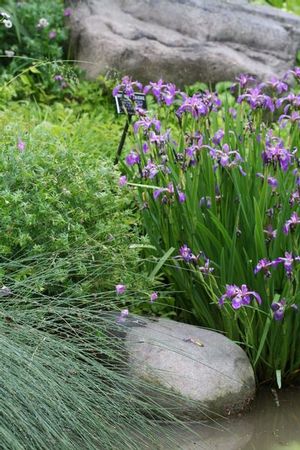Printed at http://www.newmoonnursery.com/index.cfm/

An aquatic emergent, blue flag makes a nice addition to a water garden; excellent for stormwater management and wetland areas.
Iris versicolor
Blue flag
Native to North America
FIRST IMPRESSIONS: Iris versicolor is a vigorous perennial that forms small colonies from a network of underground rhizomes. Plants produce clumps of distinctive narrow pointed leaves. In spring, foliage is topped by lovely blue irises. This unique wildflower sparkles in sunny moist or wet sites.
HABITAT & HARDINESS: Iris versicolor is native in the southern Canadian provinces from Newfoundland and Labrador to Manitoba. Plants range from Maine to Virginia and west to Minnesota and Kentucky.
This handsome iris is usually considered to be a marginal or emergent aquatic species. Plants are indigenous to marshes, swamps, shorelines, wet meadows, margins of ponds and creeks, sedge meadows and borders of wetland forests.
Plants are hardy in USDA Zones 2-7.
PLANT DESCRIPTION: Iris versicolor grows in large clumps or patches that originate from thick creeping rhizomes.
The sword shaped leaves are up to 30” tall and 1-2” wide. Leaves overlap at the base and fold around the adjacent leaf to form a flat fan-like arrangement.
In spring leafless flower stalks bear 3-5 blue-purple or violet flowers. Each bloom is 3-4” wide with darker purple veins.
The blooms have a typical iris form with 3 drooping sepals called “falls” and 3 small upright petals called “standards”. The falls are marked with a yellow blotch surrounded by a white border.
Angular capsules form after flowering. The seeds are covered in a corky deposit that allows them to distribute by floating in water.
Plants are 2-3’ tall with a 2-3’ spread.
CULTURAL & MAINTENANCE NEEDS: Iris versicolor grows best in sites with full sun or part shade. Plants thrive in moist or wet acidic soils that are high in organic matter.
This versatile wildflower prospers in clay and mucky soils, thrives in 2-4” of standing water and tolerates short periods of drought. Plants filter excess nutrients from ponds and creeks and are often planted to improve water quality. This iris appreciates a layer of mulch to protect the shallow rhizomes from sunburn. Plants are somewhat pest resistant and foliage is unpalatable to deer and other herbivores.
LANDSCAPE USES: Iris versicolor is an excellent Accent for a Water Garden or Stormwater Detention Basin. Small Groups or Masses of plants can provide Attractive Foliage, showy Spring Flowers, Cut Flowers and Erosion Control to wet sunny sites. This species is a valuable component of Cottage Gardens, Deer Resistant Plantings, Low Maintenance Plantings, Perennial Borders, Rain Gardens, Wetlands and Wildlife Gardens.
COMPANION & UNDERSTUDY PLANTS: Iris versicolor mingles cheerfully with Asclepias incarnata, Carex muskingumensis, Chelone glabra, Eupatorium perfoliatum, Osmunda cinnamomea and Rhexia virginica.
TRIVIA: Flowers are visited by butterflies and are very attractive to hummingbirds.
Iris virginica is a similar species that occurs in wetlands in the southern part of the Iris versicolor range. Iris virginica is shorter (to 2’) with leaves that often flop on the ground or in the water.
Iris versicolor is the provincial flower of Quebec.
The common name “flag” comes from a Middle English word (flagge) that means rush or reed. The specific epithet veriscolor means having various colors and refers to the different colored markings of the flower.
Height:
2-3 ftSpread:
2-3 ftUSDA Hardiness Zone:
2-7Bloom Color:
BlueIris versicolor Characteristics
Attracts Wildlife
- Hummingbirds
Attributes
- Naturalizing
- Bog
Exposure
- Full Sun to Partial Shade
Deer Resistant
- Deer Resistant
Flowering Months
- June
- May
Foliage Color
- Green
Soil Moisture Preference
- Wet to Moist
Interesting Notes:
For more information on this plant, visit the USDA PLANTS Database: http://plants.usda.gov/java/profile?symbol=IRVE2
